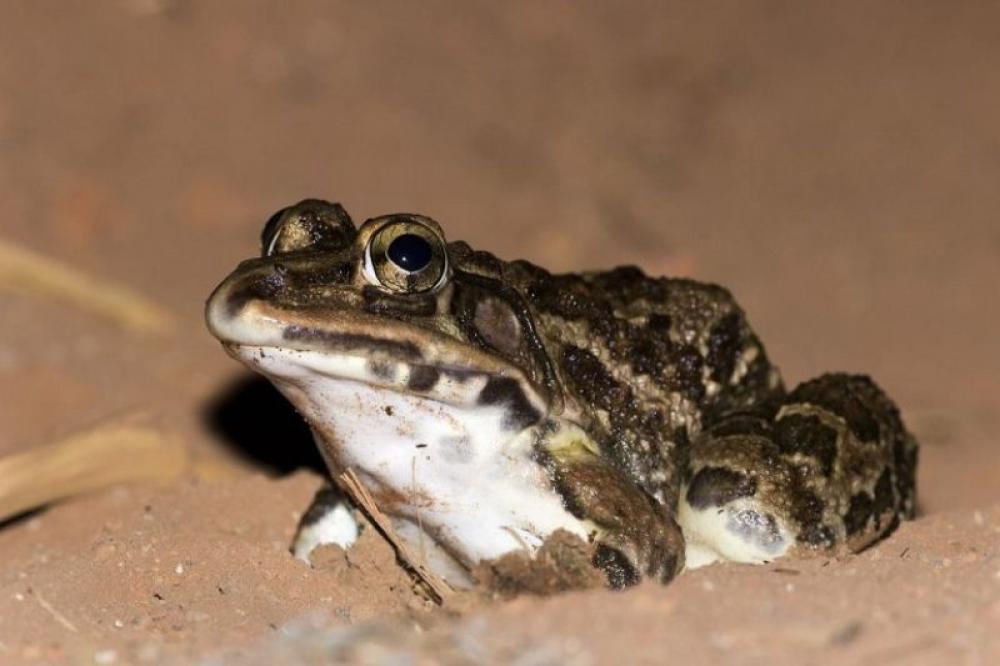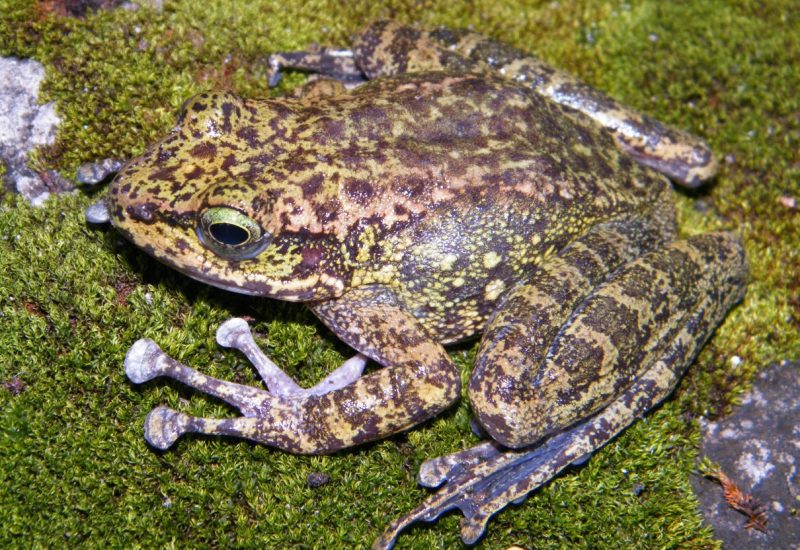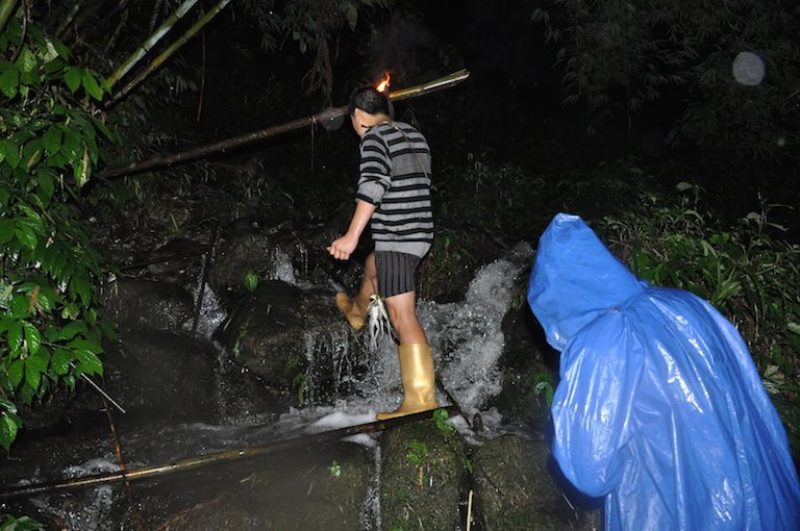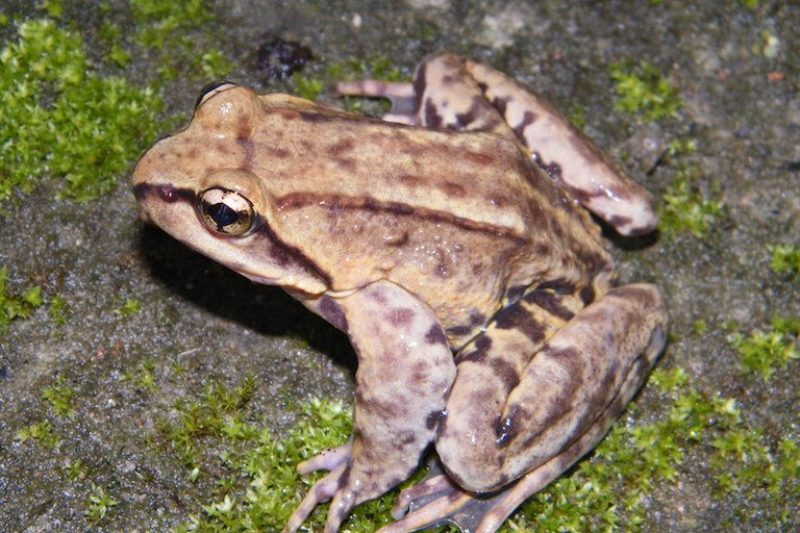Sahana Ghosh | @justearthnews | 28 Mar 2018, 06:17 am Print

Come June, with the arrival of the monsoon, a symphony of frog croaks rents the air in Sikkim situated in the lap of the Himalayas. However, their time is up. Amid the crooning of these cold-blooded vocalists, are sounds of human feet sloshing in the streams, torch in hand and a bag in another.
They are being hunted for their tasty hind legs and for alleged medicinal properties, and experts have flagged this practice of harvesting the amphibians by locals, as a potential threat to their survival.
“Hunting of frogs is done with two reasons mainly – meat and medicine. They use frogs to cure many ailments which are not validated scientifically,” says Basundhara Chettri, assistant professor, Department of Zoology, Sikkim Government College.

A cascade frog (Amolops marmoratus) that is commonly harvested in Sikkim. Photo by Basundhara Chettri
“Based on surveys in different places in Sikkim, we observed that local people collect amphibians from various streams, during monsoon season (June – September) from dusk to early night hours. This also overlaps with the breeding season of the frogs,” Chettri said while discussing the issue at IIT-Guwahati organised ‘Biodiverse’ conference.
The most preferred species are Amolops spp., Nanorana spp. and Xenophrys spp., although all kinds of frogs are hunted. According to an annotated checklist of amphibians of Sikkim Himalayas, 23 species of amphibians are reported in the region, of which 19 are frogs. Of these, the hill stream-dwelling torrent frog (Amolops formosus; locally known as ‘peeray paa’), Liebig’s paa or spiny-armed frog (Nanorana liebigii), Mountain cascade frog (Amolops marmoratus) and toads of the genus Xenophrys are being widely harvested.
Chettri maintains frogs are harvested for consumption and not for commerce. “There is no commercial exploitation in Sikkim. People extract frogs for their own consumption.The collection is used as meat supplement as well as for some medicinal purposes after smoke drying. But the medicinal role is not scientifically validated,” Chettri emphasised.
Harvesters are oblivious of the impact of collection on amphibian population and view extraction as a way of utilising natural resources before they are wasted.
“They believe that frogs are nature’s gift to them like fruits and die out after some span of time even if not collected. Hence, extraction is one way of harvest before the natural resources are wasted or rotten. The perception is that if they collect more, the number of amphibians will increase in the subsequent years,” Chettri and co-author state in a survey report.
“In some cases, it was found that most collectors pretend to be ignorant about rules and regulations of the government and legal action against such extraction,” they add in the report.
Wildlife harvesting
Wildlife harvesting is one of the most important threats to vertebrate populations, and the extent and impact of hunting of amphibian populations in Sikkim should be more thoroughly investigated, underlines Barkha Subba, a research scholar from Ashoka Trust for Research in Ecology and the Environment (ATREE).
Warning of local extinction of species, she suggests some of the hunted species may warrant a higher IUCN risk classification.
“Some species of frogs show ecological and genetic traits like torrential stream breeding, restricted geographical range and philopatry (coming to breed in the same stream year after year) that makes them highly vulnerable to population decline associated with human-induced stressors such as hunting, which may lead to local extinction of the species,” Subba told Mongabay-India.
Hunting practices are also intricately linked to tribal traditions. She narrates Lepchas and some other tribes like the Limboos are originally hunter gatherers, and each year they have a festival for celebrating and worshipping the hunting God, whereby the male members of the family are required to spend a day in the jungle worshipping and hunting.
“During my interviews with the male members of these tribe I found out that since the laws have become stricter (Wildlife Protection Act 1972), the hunting of bigger game has become risky and they would go for small animals like frogs for the sake of the ritual of hunting,” Subba said.
However, with the improvement in economy and education system in Sikkim, most youngsters are now educated away from their villages, in towns and other states, and are not very keen on participating in the hunting ritual, enlightened Subba.
Though there is no detailed study on demography of all the harvested frogs in Sikkim, it is safe to say that these frogs maybe at risk and the vulnerability of these species should be carefully reviewed.
‘Jumping Chicken’
To protect the country’s dwindling frog population, India banned the collection and export of native frogs in the 1980s, highlighting the role of frogs in controlling agricultural pests and mosquitoes.
However, Subba laments, the extent of amphibian intake for local consumption remains understudied and diversity of species consumed locally is probably under-recorded.

Frog collection in Sikkim. Photo by Barkha Subba
“Though the export of frog legs was banned in the 1980s, frog legs are available in northeast and south India,” said amphibian biologist S. D. Biju from The University of Delhi. “If you go to markets in Manipur, Nagaland etc, you will find frog meat, irrespective of the breeding time or stage of development. Though habitat degradation is the major issue for declining frog population, over-harvesting is also a concern.”
There is also Goa’s ‘Jumping Chicken’, a code name for the popular local delicacy of frog’s legs, with taste and texture said to resemble that of chicken. The frogs sought after most being the Indian bullfrog (Hoplobatrachus tigerinus) and Jerdon’s Bullfrog (Hoplobatrachus crassus). Despite legal protection, poaching and trade of the animals for ‘Jumping Chicken’, still continues, according to Saket Badola, Head of TRAFFIC’s India office.
Fresh water frogs are protected under Schedule IV of the Wildlife (Protection) Act, 1972, which prohibits hunting of, or trade in the species and its parts. The species is also listed in Appendix II of the Convention on the International Trade in Endangered Species of Wild Fauna and Flora (CITES), of which India is a signatory, that prohibits the export of the species for commercial purposes from India.
“Illegal wildlife trade has also gained ground on the Internet. A wide range of protected species is openly advertised on popular websites around the world. While efforts have been intensified to strengthen on the ground enforcement to curb this trade, regulating Internet-based trade has not been sufficiently addressed,” Badola adds, advocating the need to monitor these ‘virtual’ markets in order to “bring an end to this growing threat.
Canary in the coal mine
In many habitats, amphibians in a ‘conveyor belt’ fashion provide for “transfer of invertebrate energy sources to predatory animals higher up in the food chain- to the many species of reptiles (particularly snakes) and some birds and mammals, that are unable to access directly the invertebrate food source.”
“They also are a major food source for freshwater fish. Amphibians, are among the first organisms to suffer from the effects of global pollution and climate change- providing an early warning of environmental degradation,” Subba notes.

One widely harvested species is the spiny-armed frog (Nanorana liebigii). Photo by Basundhara Chettri
In addition to hunting, amphibian habitat is also disturbed during fishing as collectors divert water from the stream to another side. In this process, a large number of eggs and tadpoles are dehydrated and die, observes Chettri.
“This activity has posed a serious threat to the amphibian population as well as their habitat (especially breeding) causing population decline. Anthropogenic disturbances to breeding habitats of amphibians are considered as the most serious threat for population decline worldwide,” Chettri says.
Mining, at different scales, from smaller streams to rivers and the ensuing rampant extraction of sand, gravel and boulders affects the amphibian microhabitat, another big threat to the diversity of amphibians and other aquatic fauna in Sikkim, pointed out Chettri.
Biju and Chettri are in agreement that “conservation practices are more biased towards larger and more glamorous species” despite the fact that smaller ones have their own importance in the scheme of things.
There is also a thin line between protection of traditional knowledge (TK) and biodiversity conservation. “Random extraction is not propagated by traditional knowledge. In fact, traditionally extraction was done only post-breeding period. Holders of TK will not encourage random extraction,” explained Chettri.
“India has 405 species of amphibians and still counting with new discoveries being made each year. Out of these, 308 species are endemic to India, i.e. found nowhere else in the world. With the rising stressors of anthropogenic creation like habitat loss and degradation, hunting, pollution, global warming, if we do not act towards the conservation of amphibians now, then they might be lost forever,” Subba cautions.
Text and Image: Mongabay India
Banner Image: Siddhesh Sawant/Wikimedia Commons/Mongabay India
- Rain-related incidents in Pakistan's KP leave 21 dead
- Heavy rains and floods disrupt normal life in Dubai, flights diverted
- NOAA scientists say coral reefs undergoing fourth global bleaching event
- Skygazers stunned as they witness total solar eclipse in the US, Mexico, Canada amazed
- Total Solar Eclipse to occur on April 8, NASA shares safety guidelines for viewing the event






